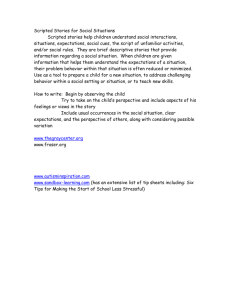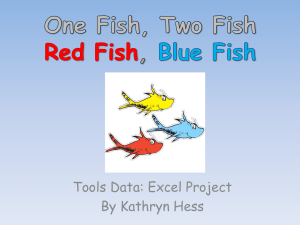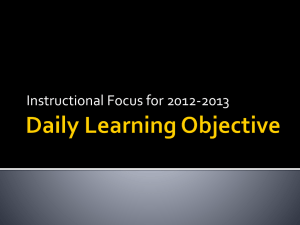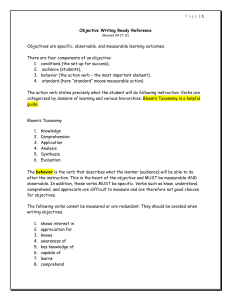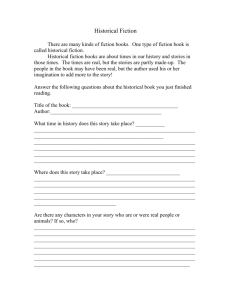prioritize your learning goals
advertisement
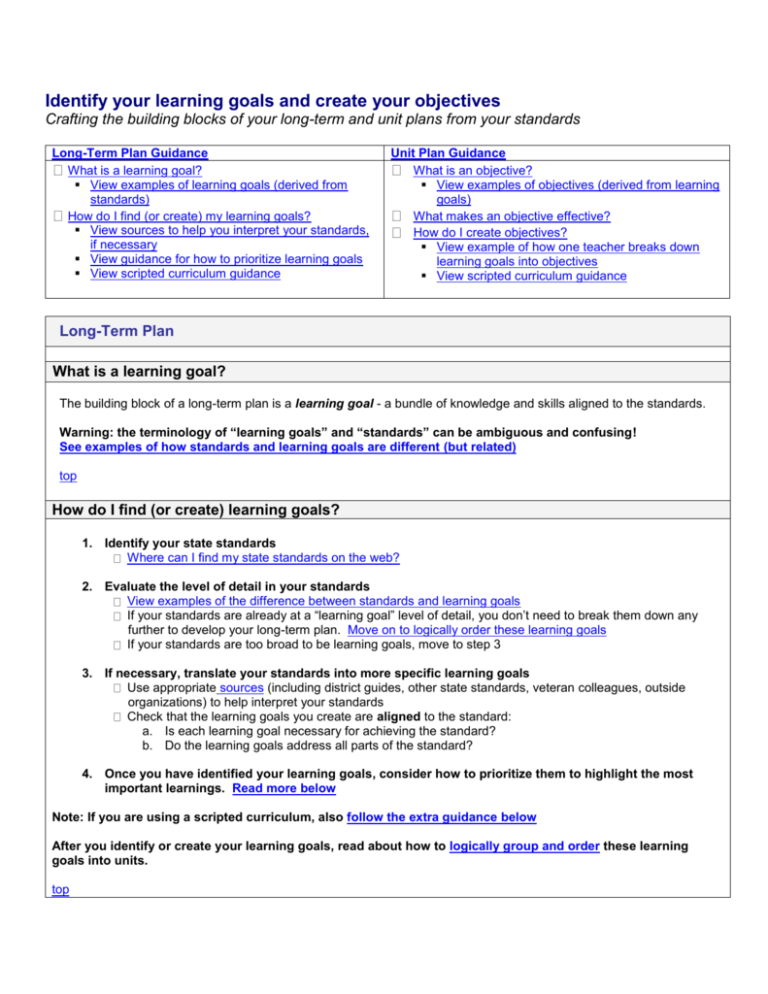
Identify your learning goals and create your objectives Crafting the building blocks of your long-term and unit plans from your standards Long-Term Plan Guidance What is a learning goal? View examples of learning goals (derived from standards) How do I find (or create) my learning goals? View sources to help you interpret your standards, if necessary View guidance for how to prioritize learning goals View scripted curriculum guidance Unit Plan Guidance What is an objective? View examples of objectives (derived from learning goals) What makes an objective effective? How do I create objectives? View example of how one teacher breaks down learning goals into objectives View scripted curriculum guidance Long-Term Plan What is a learning goal? The building block of a long-term plan is a learning goal - a bundle of knowledge and skills aligned to the standards. Warning: the terminology of “learning goals” and “standards” can be ambiguous and confusing! See examples of how standards and learning goals are different (but related) top How do I find (or create) learning goals? 1. Identify your state standards Where can I find my state standards on the web? 2. Evaluate the level of detail in your standards View examples of the difference between standards and learning goals If your standards are already at a “learning goal” level of detail, you don’t need to break them down any further to develop your long-term plan. Move on to logically order these learning goals If your standards are too broad to be learning goals, move to step 3 3. If necessary, translate your standards into more specific learning goals Use appropriate sources (including district guides, other state standards, veteran colleagues, outside organizations) to help interpret your standards Check that the learning goals you create are aligned to the standard: a. Is each learning goal necessary for achieving the standard? b. Do the learning goals address all parts of the standard? 4. Once you have identified your learning goals, consider how to prioritize them to highlight the most important learnings. Read more below Note: If you are using a scripted curriculum, also follow the extra guidance below After you identify or create your learning goals, read about how to logically group and order these learning goals into units. top Unit Plan What is an objective? Units are organized around objectives – the most concrete, distilled components of a standard See examples of how objectives can be derived from learning goals and standards What makes an objective effective? An effective objective must be: Student Achievement-Based Focused on what students must know or be able to do (SWBAT…) Measurable Organized around a clear action verb Rigorous Aligned to the big goal and at the appropriate cognitive level How do I create objectives? 1. Identify your learning goals (from your long-term plan) 2. Analyze the items on your summative unit assessment to help break down your learning goals into smaller pieces. Consider the following questions: What specific knowledge would you need to have in order to answer this question? What concepts or understandings would help you organize that knowledge when approaching this question? What will students need to be able to do with their knowledge to be able to answer this question? What additional skills would students need in order to answer this question? 3. Interpret your learning goals using these guiding questions: What are the key nouns and verbs that describe your learning goals? What do these nouns and verbs indicate about the knowledge and skills will students need in order to master these goals? Typically the nouns relate to knowledge and the verbs relate to skills students will need What tasks and understandings are associated with the learning goals? Read an example of a teacher modeling this process 4. Write the objectives so they meet the criteria above Start objectives with the phrase “Students will be able to … ” (SWBAT) to ensure that they are studentachievement based Use clear action verbs to ensure they are measurable Make sure at least one of your objectives meets the Bloom’s level of the learning goal Determine if your objective meets student’s academic levels – (neither too ambitious nor too easy). You will know this by examining your diagnostic (or other assessment) data Reflect on the connection to the big goal – will the knowledge or skill of this objective be important for achieving your year end goals? Note: If you are using a scripted curriculum, follow this extra guidance. After you have created your objectives, read about how to order them in a logical sequence. top Examples of translating standards into learning goals into objectives top WHAT STUDENTS NEED TO KNOW Instructional Examples Guidance “Standards” (If necessary) Long-Term Plan (a.k.a. essential knowledge and skills, competency goals, learning standards, competencies) Most general The broadest level of guidance for academic expectations Unit Plan “Objectives” Most specific (a.k.a., benchmarks, essential elements, essential skills, performance standards) Bundles of knowledge and skills - the components of standards “Learning Goals” Concrete building blocks of a lesson - the components of learning goals A. Students learn and effectively apply a variety of reading strategies for comprehending, interpreting and evaluating a wide range of texts including fiction, nonfiction, classic and contemporary works. B. Students will investigate structure and function in living systems. C. Students demonstrate an understanding of the notion of differentiability. A. Students will be able to use reading strategies such as making inferences and predictions, summarizing, paraphrasing, differentiating fact from opinion, drawing conclusions, and determining the author’s purpose and perspective to comprehend written selections. B. Students will identify, compare, and contrast levels of organization including cells, tissues, organs, organ systems, and organisms. C. Students demonstrate an understanding of the derivative of a function as the slope of the tangent line to the graph of the function. A. Students will be able to distinguish fact from opinion. B. Students will be able to compare and contrast the structure and function of the human circulatory and respiratory systems. C. Students will be able to calculate the derivative of a second order function. How standards, learning goals, and objectives relate to each other... STANDARD 1 LEARNING GOAL A Objective 1 Objective 2 Objective 3… LEARNING GOAL B LEARNING GOAL C LEARNING GOAL D Each standard can be broken down into different learning goals, which, in turn, can be distilled into multiple objectives. Learning goals are too broad to reach in one lesson; objectives are the basic unit of teaching. See more examples of standards broken into learning goals learning goals broken into objectives Important Note: As the chart above suggests, a variety of terminology is used in describing standards and learning goals. In addition, different states vary in the level of guidance they provide around standards. Many states break down their broad standards into more specific learning goals (bundles of skills and knowledge) while other states use “standards” that already exist at a learning goal-level of detail. top back to “what is a learning goal?” back to “what is an objective?” This example below shows how a broad standard (in bold) can be broken into a bundled list of aligned learning goals. G e or g i a P erf orm anc e St a nd ar ds : Ma t hem at i c s 1 ( A lg e bra) 1 MM1A1. Students will explore and interpret the characteristics of functions, using graphs, tables, and simple algebraic techniques. a. Represent functions using function notation. b. Graph the basic functions f (x) = xn, where n = 1 to 3, f (x) = x, f (x) = |x|, and f (x) = 1/x. c. Graph transformations of basic functions including vertical shifts, stretches, and shrinks, as well as reflections across the x- and y-axes. d. Investigate and explain the characteristics of a function: domain, range, zeros, intercepts, intervals of increase and decrease, maximum and minimum values, and end behavior. e. Relate to a given context the characteristics of a function, and use graphs and tables to investigate its behavior. f. Recognize sequences as functions with domains that are whole numbers. g. Explore rates of change, comparing constant rates of change (i.e., slope) versus variable rates of change. Compare rates of change of linear, quadratic, square root, and other function families. h. Determine graphically and algebraically whether a function has symmetry and whether it is even, odd, or neither. i. Understand that any equation in x can be interpreted as the equation f(x) = g(x), and interpret the solutions of the equation as the x-value(s) of the intersection point(s) of the graphs of y = f(x) and y = g(x). top back to “what is a learning goal?” This example shows how different learning goals can be broken down into objectives Learning Goal The student will measure distances on a variety of maps The student will analyze energy of position, including gravitational potential energy and elastic potential energy. 1 Translates into Translates into Objectives The student will be able to use the map’s index and grid to locate two geographical points. The student will be able to accurately measure the distance between two points in inches and centimeters. The student will be able to convert the distance on a map to the actual distance between two places using the map scale. The student will be able to calculate distances between two points on 1) a map of Africa and 2) a map of one African nation. The student will be able to explain the difference between gravitational potential energy and elastic potential energy. The student will be able to solve word problems involving gravitational and elastic potential energy. The student will be able to analyze the gravitational potential energy of real objects at different heights. The student will be able to analyze the elastic potential energy of real springs with different spring constants. Standards HS Math 1 July 2006. http://www.georgiastandards.org/DMGetDocument.aspx/Standards%20HS%20Math%201%20July%202006.pdf?p=6CC6799F8C137 1F6A53EDDBCD81AFF25221C13C3F28F0C3131F77C63ACAF4698&Type=D, accessed 12/20/07. The student will develop a topic sentence and supporting sentences. Translates into The student will be able to identify the topic sentence and supporting sentences in a paragraph. The student will be able to describe the purpose of a topic sentence and supporting sentence. The student will be able to evaluate a topic sentence to ensure that it represents its paragraph’s main idea. The student will be able to evaluate supporting sentences to ensure that they reinforce the paragraph’s main idea. The student will be able to write a paragraph with a topic sentence and supporting sentences. top back to “what is an objective?” Qualities of effective objectives: (1) Lesson objectives must be STUDENT - ACHIEVEM ENT BASED. The best way to draft objectives is to start with the phrase “The student will be able to…” (represented by the acronym “SWBAT”), and ensure that the objectives are derived from your course learning goals. If you look at your standards and learning goals (and most of the examples included in this text), you will most likely see that they are already student-achievement based. States and districts usually include the phrase “the student will…” or “the student will be able to….” This approach to drafting objectives helps avoid some of the most common mistakes teachers make as they approach unit and lesson planning. Unfortunately, there are many classroom examples of non-studentachievement focused objectives. “Continuing to cover poetry,” or “Completing the worksheet,” or “Group work on African history,” are not useful objectives because they offer no indication of what learning you want the students to achieve. They offer no guidance or focus in the lesson planning process and do not help you to determine when you have succeeded with your lesson. In contrast, the objective “The student will be able to identify, describe the rhythm and rhyme structure for, and write a limerick” provides you with a specific, student-oriented focus for your lesson. By beginning every lesson objective with the phrase “The student will be able to…” you discipline yourself to ensure that you’re driving toward student achievement. Keep in mind as we discuss lesson objectives that a teacher does not always teach one unique lesson objective per class per day. While it is a helpful habit to attempt to think of objectives in such discrete pieces, the reality is that sometimes it takes more or less than one class session to master an objective. You may have a set of objectives being addressed in one class period, or you may find yourself investing a few days of class time on one objective. Either way, be sure you identify exactly what your students need to accomplish by the end of each class period and how you will know whether they have, in fact, achieved this goal. top back to “what makes an objective effective?” (2) Lesson objectives must be MEASURABLE . Objectives serve as the key tool for evaluating your own and your students’ success on a daily basis. If students achieve the lesson objective, the lesson is successful; if students do not achieve the objective, you must acknowledge that there is still material to be learned and most likely you must re-teach the objective in a different way. In order to determine confidently whether students have achieved the lesson objective, the objective must be measurable. What makes an objective measurable? In a word, the verb. By carefully choosing a verb for your objective that lends itself to assessment, you will greatly enhance your lesson’s efficacy. For example, if an objective reads, “The student will be able to understand that bones help the body,” how would the teacher measure that understanding? If an objective reads, “The student will learn about the phases of the moon,” or “The student will enjoy food from different cultures,” how would the teacher measure achievement of those objectives? The verbs understand, learn, and enjoy are relatively vague. On the other hand, changing “the student will be able to understand that bones help the body,” to “the student will be able to list three ways bones help the body,” you have built into the objective a means of knowing when you have reached it. Instead of planning to help students learn about the phases of the moon, your objective could be for students to be able to explain the cause of the moon’s phases and correctly identify the different phases by name. Let’s consider several lesson objectives and analyze them in light of the criteria we have outlined above. BEFORE REVISION The student will understand the major parts of speech in a sentence. The teacher will present a lesson on ordering fractions with different denominators. The student will enjoy the rhyming schemes in different types of poetry. The teacher will discuss the implications of cloning human beings. The student will learn the conditions in Europe that led to World War II. The student will be able to list the phases of the water cycle. The student will be able to write a short biography of a famous individual based on research from multiple sources. ANALYSIS OF OBJECTIVE This objective is not measurable. How will you know for certain whether students understand? This objective is not studentachievement based. This objective is not measurable. How do you measure student enjoyment? This objective is not studentachievement based. This objective is not measurable. This objective is studentachievement based and measurable. This objective is studentachievement based and measurable. AFTER REVISION The student will be able to identify and define the major parts of speech in a sentence. The student will be able to order fractions with different denominators. The student will be able to compare and contrast the rhyming schemes in different types of poetry. The student will be able to evaluate the implications of cloning human beings. The student will be able to explain the conditions in Europe that led to World War II. No revisions necessary. No revisions necessary. (This objective encompasses several lesson objectives, and might come at the end of a unit, perhaps as the end-of-unit assessment.) top back to “what makes an objective effective?” (3) Lesson objectives must be RIGOROUS. Aligned to the big goal As you plan your objectives, you should always be thinking, “Why is this knowledge or skill important to the larger goal?” and “Does this meet or build to the academic bar set by the big goal?” This step requires you to clearly articulate a lesson objective’s purpose in terms of how it is integral for reaching the overall big goal. Rigorous objectives should clearly relate to your unit and course goals and serve as necessary steps towards achieving the standard established by your big goal. Objectives that don’t have necessary, logical connections to reaching the demands of your big goals are ineffective because they will not ultimately move your students forward in their path toward academic achievement. Aligning objectives to the big goal not only prepares you to reach your destination but can also help focus and motivate students. If you ensure that students understand this connection, it will remind them of the bigger instructional picture and provide them with a concrete rationale for why they are learning this particular objective. This will help in continually reinforcing the meaning and significance behind classroom activities. At the appropriate cognitive level As seen above, measurable, student-achievement based objectives contain a carefully chosen verb (such as write, list, measure, evaluate, calculate, and categorize) that helps drive the objective’s focus. A teacher should be aware that the choice of verb also affects the cognitive level of the objective. That is, particular verbs address a lower level of thinking, and others address a higher level of thinking. View how different objectives fit into Bloom’s Taxonomy To be at the appropriate cognitive level, a teacher must consider: The cognitive level of the learning goals. The highest cognitive level of the objectives must be at least as high on Bloom’s as the original learning goal. If the learning goal expects students to reach the level of synthesis, for instance, and you only ask students to describe or explain the topic (the “comprehension” level on Bloom’s), then your objectives would be insufficiently rigorous to lead students to master that learning goal. At least one objective should reach the cognitive level of your learning goal in order for your objectives to be at the appropriate level of rigor. The academic starting point of your students: Where are your students in relation to the cognitive level of the objective? Before you can reach high levels of Bloom’s Taxonomy, you must help your students with the lower rungs. If you want your class to be able to compare and contrast different types of rocks (analysis), be sure they can first name the three types (knowledge), describe the characteristics of each in their own words (comprehension) and classify unlabeled rocks as members of one of the three groups (application). Along the same lines, students obviously can’t analyze the use of adjectives in a passage if they do not know what an adjective is. And conversely, you shouldn’t teach students how to find the Fahrenheit and Celsius sides of the thermometer if they already know how to read and write both types of temperatures. It is therefore important to consider your students’ current achievement levels and all of the pre-requisite skills and knowledge that your goals assume when fashioning your list of lesson objectives. Your objectives will be inappropriately rigorous if they are too ambitious (i.e. students are not prepared to perform up to the objective’s level) or are not ambitious enough (i.e. students have already mastered the objective). Finding the right balance is the key for providing students the appropriate level of challenge, rather than frustrating or boring them with objectives that are not of the appropriate rigor. The age/developmental level of your students. As the Learning Theory course explains in much more detail, younger students often are still building their lower-level thinking skills and are more successful when considering concrete concepts. Of course, teachers should push young students to higher cognitive levels when they have the appropriate foundation and should always depend on a varied blend of different cognitive levels. Older students usually are able to operate at a higher level of thinking and can reason abstractly, so you can push them to application, analysis, synthesis, and evaluation. Remember, to help determine the level you should expect your students to reach, you can also revisit your big goal and consult the expectations at high performing schools for students in your subject and grade level. top back to “what makes an objective effective?” Guidance for Prioritizing Learning Goals After you have created a list of learning goals aligned to your standards, the next step is to identify the learning goals that are most central, or highest-priority, for your grade level and course. Why? By knowing the most important things that students should take from the year, you can make decisions about how much time to allot to certain topics and how to focus on the aspects of a topic that are most critical to student understanding. What makes one learning goal more central than another? Not all learning goals are created equally. In fact, many educational leaders believe that trying to cover every learning goal with equal effort often leads to shallow teaching and learning. If you try to teach one learning goal per day so that you "cover" everything, chances are good that students may not learn much about anything. Some learning goals are more essential than others and require more time and attention to achieve. We call these "prioritized learning goals." Some states refer to them as power standards. How do I identify my prioritized learning goals? Rest assured, you don’t need to do this alone, nor should you. Plenty of teachers, districts, and national organizations have developed resources that can help, and it is important to take great caution when identifying your prioritized learning goals. You will take the first step in this process today so that you enter your classroom with context around what is important. However, you shouldn't set your list in stone today. As you meet your students and learn nore about your course, you will revisit these learning goals and solidify your list. What are the criteria for prioritized learning goals? ENDURANCE Teachers must ask them selves, "Will this learning goal provide students with knowledge and skills that will be of value beyond a single test date?" Think of it this way: writing proficiency will endure throughout a student's school career and professional life. Example: 5th grade geometry- Identify relationships among points, lines, and planes (e.g., intersecting, parallel, perpendicular). Rationale: This learning goal requires students to use coordinate graphs to plot points in a plane. This is an enduring learning goal because the physical foundations of Euclidean geometry are points, lines, and planes. Here all of those basics are introduced and explored, and as students master this goal, they are prepared to build upon their knowledge of geometry in years to come. LEVERAGE "Will this learning goal provide knowledge and skills that will be of value in multiple fields of study?" For example, the ability to create graphs and charts as well as draw accurate conclusions from them will help students in math, science, social studies, and language arts. Example: 6th grade English/Language Arts - Identify and use organizational structures in text, including chronological order, comparison and contrast, cause and effect, logical order, and classification schemes. Rationale: This learning goal gives students the tools and strategies they need to use the organizational structures within texts as clues to meaning. Students will be able to leverage this set of skills as they read and interpret texts in science, social studies, literature, and math. READINESS FOR THE NEXT LEVEL OF LEARNING "Will this learning goal provide students with essential knowledge and skills that are necessary for success in the next grade or level of instruction?" This simply could mean that a third grader must be proficient in 3rd grade level reading comprehension to enter the fourth grade and pursue 4th grade level studies with success. However, the ability to assemble a rock collection is not requisite for success in the 4th grade. Example: 4th grade writing - Create paragraphs that 1) establish and support a central idea in a topic sentence; 2) include supporting sentences; 3) include a concluding statement; 4) are indented properly. Rationale: In Washington, D.C. where this learning goal comes from, fourth grade is that last grade that focuses on writing instruction at the paragraph level. All subsequent grades require students to produce multi-paragraph compositions. Students must master this high-priority learning goal in order to achieve writing success in the fifth grade. MISCONCEPTION ALERT Prioritization does not necessarily mean elimination. The prioritized standards are those that receive special consideration when you are planning your units and developing your assessments. They may take longer to teach and you will want to be sure students master them to the fullest extent. The learning goals that are not prioritized will still be taught and your students will develop familiarity of them. top back to “how do I find or create learning goals?” Sources to help you translate your standards into learning goals Your district curriculum guide. School districts often re-publish the state standards with greater specificity (aligning them with the district’s resources, for instance), so be sure to ask your colleagues, grade-level chairperson, department head, principal, or district director of instruction if such a curriculum guide exists. If you ask how the standards in your district are “vertically aligned,” you may secure a document that details how different grade levels should address similar learning goals. Outside organizations. Professional organizations (e.g., National Council of Teachers of Mathematics (NCTM) or the National Science Foundation (NSF)), and for-profit organizations (e.g., CORE Knowledge Foundation) have also developed comprehensive standards and guides for teachers, and they can serve as additional sources of insight as you try to determine what it means for students to meet certain academic goals. For instance, the NCTM’s guide provides advice for the types of math problems that students should be able to solve at different grade levels. No list of state standards is that nuanced and helpful. Other districts or states. Because of the increased focus on standards, many districts have devoted significant resources to developing extensive, standards-based curricula, and post their guides online. If your state’s standards baffle you, try comparison-shopping with another state. For example, California’s science guidelines are particularly strong and specific, outlining that eighth graders should know, among other facts and concepts, that “the greater the mass of an object, the more force is needed to achieve the same rate of change in motion.” This clearly provides more guidance than “students will be able to understand force.” View where to find national and regional standards on the internet. Veteran Teachers. See the long-term plans of colleagues at your school. They may be able to show you how they break standards into manageable chunks to be used in planning out the year. top back to “how do I find or create learning goals?” Example of how a teacher breaks learning goals into objectives I'm going to use this 3rd grade reading learning goal: SWBAT distinguish fact from fiction to model the process of unpacking a learning goal. It comes from the broad standard you see above it. I need to determine the knowledge and skills that are embedded in the larger goal. Remember, knowledge refers to the things students have to know; those are the nouns of the objective. Skills are the actions students have to take; those are the verbs of the objective. I'll start by identifying the knowledge components of the goal. What concepts will my students need to understand in order to master this learning goal? Just by looking at the nouns, I can see that students will have to know what fact and fiction are. That seems straight forward enough. Now, I'll determine the skills involved. The only verb in the learning goal is "distinguish". But, I know from Bloom's Taxonomy that the skill of distinguishing is at the analysis level, which is a higher cognitive level. Students probably won't be able to jump right in and distinguish between fact and fiction. So even though distinguish is the only skill given, I will have dig a little deeper to unpack the more foundational skills my students will need to master that will lead them to be able to distinguish between fact and fiction. What actions will I have to teach my students to take? What actions will I be observing for as they work? If I can clarify for myself what I expect to see from my students, then I know I have a better chance of having lesson objectives that are measurable. I'm going to refer back to Bloom's Taxonomy so I can trace the steps my students will have to take before they can master the learning goal at the level of rigor it requires. [Show Bloom's chart] So here's where my students need to end up. [highlight analysis level on Bloom's chart] I'll work backwards from here. I can see that I will also need to have objectives at the application, comprehension, and knowledge levels so that I can scaffold my students' learning. [arrow up the chart/highlight each level]I'm going to get started identifying the actual objectives for my lessons. I think the ultimate objective for this learning goal is SWBAT examine the factual and fictional elements in their reading and explain their distinguishing characteristics. I'd like them to be able to do this using the same topic because it will prepare them to identify bias in text as they get a little older. I'll just note that as (same topic) in my objective. At the application level, I should see that my students can classify info from their reading as either fact or fiction. [screen shows side by side Blooms and objectives being written] At the comprehension level, I can see that my students will need to do many things before they can classify info. First they'll need to identify examples of both fact and fiction in their reading. [SWBAT] Then they'll describe in their own words why the information is either fact or fiction. [SWBAT] At the knowledge level students will need to develop a basic understanding of what fact and fiction are. They won't be able to master any of the other objectives without this foundation. So, at this basic level the objectives are: SWBAT articulate that a fact is a piece of information that can be proven true; a fact is real. SWBAT articulate that fiction is not real; it is the opposite of fact. So, you can see from this one learning goal at the analysis level, I have these scaffolded objectives: Learning goal: SWBAT distinguish fact from fiction Objectives: SWBAT articulate that a fact is a piece of information that can be proven true; a fact is real. SWBAT articulate that fiction is not real; it is the opposite of fact. SWBAT identify examples of both facts and fiction in their reading. SWBAT describe in their own words why the information is either fact or fiction. SWBAT classify info from their reading as either fact or fiction. SWBAT examine the factual and fictional elements in their reading and explain their distinguishing characteristics. (same topic) top back to “what how do I create an objective?” Scripted Curriculum Guidance Creating learning goals: Once you are familiar with the requirements established by your standards and learning goals, take the time to evaluate how well your scripted program matches your standards and learning goals. Published curriculums often provide an overview of the entire course and list the topics and skills that are covered on each lesson. This will be a helpful tool to use as you look for those components that directly match your learning goals. The goal is to find those components of your published curriculum that directly match the content, topics, and skills outlined in your learning goals. When you reviewed your standards, you identified the main strands, or categories, under which your content is organized. It is helpful to use those same strands to organize your analysis of the program you’ll be using. You’ll want to look specifically for evidence that your program thoroughly covers each strand. You can use the margins of your teacher’s guide to make any necessary notes that you’ll use later when you develop your goals, assessments, and plans. 1. Look for gaps in your scripted curriculum. Do you notice that your standards and learning goals hold students accountable for more knowledge and skills than your scripted program does? Keep a log of the learning goals omitted from your program. You will need to supplement with additional lessons when it comes time to teach those goals of your course. 2. Look for the “extras” in your scripted curriculum. Do you notice that your program covers skills or topics that are not also required by your standards and learning goals? Give some indication in your teacher’s guide that these components may be extraneous to teach to your entire class. You might be able to use these components for remediation or enrichment with particular students. You’ll be able to make those decisions after you get to know your students and are developing detailed unit plans. For now, simply mark them with as uncertain. top back to “how do I find or create learning goals?” Daily Objectives and Your Scripted Curriculum: One of the real benefits to having a scripted program is that much of the hard work of determining what students should be doing day to day has already been established. Yet, you need to approach this gift with caution and a keen eye, asking yourself: o “Does each objective in this unit push my students to meet the unit goals established by the unit assessment?” Your unit assessment that you already adjusted will be an invaluable tool as you look through daily lesson objectives your curriculum provides. It clearly defines learning destination for your students and can act as a decision-making point at those times when you’re questioning the necessity of a daily lesson. Please make sure you have your unit assessment with you during this portion of the class. To help you confidently address the question we posed above, we suggest this set of guidance: 1. Ensure that each lesson is a necessary step to achieve the goals of the unit. Can you trace the lesson directly back to the assessment? If so, you know that this is a lesson that needs to be taught. Are there any extraneous lessons that you can save to teach as enrichment? 2. Ensure that each lesson objective is measurable, student-achievement based, and rigorous. Every lesson objective needs to be written in a way that has meaning for both you and your students. Sometimes scripted programs give you objectives that are written in terms of what the teacher needs to do or what activity will be completed. For example, you might be given an objective like this: “The goal of this lesson is to provide practice comparing pairs of numbers.” What does that mean in terms of student learning? How will you measure student success? What sort of comparing do students need to do; what concepts will they learn; what language will be used? Make sure you know exactly what your students will know and be able to do as a result of participating in the lesson. Rewrite any objectives that are unclear, confusing, or that may not be meaningful to your students. 3. Identify the learning goals you added to your unit in your long-term plan that were not originally included in your scripted curriculum. You will need to break down these goals into measurable, student learningbased, rigorous objectives. top back to “what how do I create an objective?”

